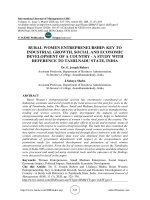Economic growth and economic development 566
Bạn đang xem bản rút gọn của tài liệu. Xem và tải ngay bản đầy đủ của tài liệu tại đây (158.82 KB, 1 trang )
Introduction to Modern Economic Growth
even though ex post monopoly power (for example, generated by patents) can induce
innovation, the incentives for innovation and the equilibrium allocations that result
in the case of innovation are still inefficient. Note also that Sb1I can be negative,
so that a potentially productivity-enhancing process innovation can reduce social
surplus because of the cost of innovation, µ. However, it can be shown that if
π
ˆ I1 > 0, then Sb1I > 0, which implies that excessive innovation is not possible in this
competitive environment (see Exercise 12.4). This will contrast with the results in
the next subsection.
12.3.4. The Value of Innovation to a Monopolist: The Replacement
Effect. Let us now analyze the same industry as in the previous subsection, but
first presuming that firm 1 is already a monopolist with the existing technology.
Then with the existing technology, this firm would set the monopoly price of
ψ
pˆM ≡
1 − εD (p)−1
and make profits equal to
¡ M¢ ¡ M
¢
π
ˆN
ˆ
pˆ − ψ .
1 = D p
If it undertakes the innovation, it will reduce its marginal cost to λ−1 ψ and still
remain the monopolist. Therefore, its profits will be given by π
ˆ I1 as in (12.3), with the
monopoly price pM given by (12.2). Now the value of innovation to the monopolist
is
∆ˆ
πI1 = π
ˆ I1 − π
ˆN
1
¡ M¢ ¡ M
¢
¡ ¢¡
¢
= D p
p − λ−1 ψ − D pˆM pˆM − ψ − µ.
Proposition 12.3. We have that
∆ˆ
π I1 < π I1 < π
ˆ I1 ,
so that a monopolist always has lower incentives to undertake innovation than a
competitive firm.
Proof. See Exercise 12.6.
Ô
This result, which was first pointed out in Arrows (1962) seminal paper, is
referred to as the replacement effect. The terminology reflects the intuition for the
552









